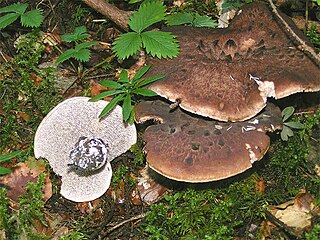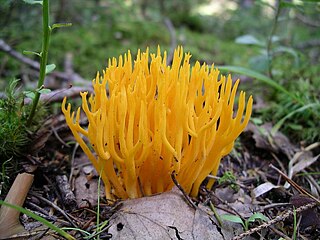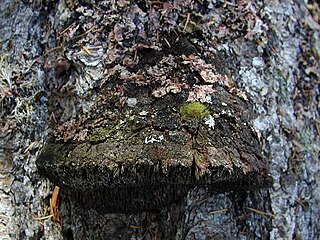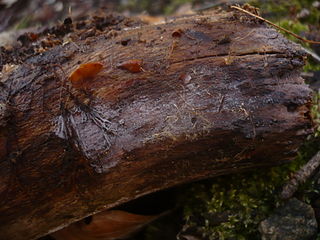
The Clavariaceae are a family of fungi in the order Agaricales. Originally the family contained most of the clavarioid fungi, but in its current sense is more restricted, albeit with a greater diversity of basidiocarp forms. Basidiocarps are variously clavarioid or agaricoid (mushroom-shaped), less commonly corticioid or hydnoid.

The Thelephorales are an order of fungi in the class Agaricomycetes. The order includes corticioid and hydnoid fungi, together with a few polypores and clavarioid species. Most fungi within the Thelephorales are ectomycorrhizal. None is of any great economic importance, though Sarcodon imbricatus is edible and commercially marketed, whilst several species have been used for craft dyeing.

The Dacrymycetaceae are a family of fungi in the order Dacrymycetales. Species are saprotrophs and occur on dead wood. Their distribution is worldwide. Basidiocarps are ceraceous (waxy) to gelatinous, often yellow to orange, and variously clavarioid, disc-shaped, cushion-shaped, spathulate (spoon-shaped), or corticioid (effused).

The Dacrymycetes are a class of fungi in the Basidiomycota. The class currently contains the single order Dacrymycetales, with a second proposed order Unilacrymales now treated at the family level. The order contains four families and has a cosmopolitan distribution.

The Hydnaceae are a family of fungi in the order Cantharellales. Originally the family encompassed all species of fungi that produced basidiocarps having a hymenium consisting of slender, downward-hanging tapering extensions referred to as "spines" or "teeth", whether they were related or not. This artificial but often useful grouping is now more generally called the hydnoid or tooth fungi. In the strict, modern sense, the Hydnaceae are limited to the genus Hydnum and related genera, with basidiocarps having a toothed or poroid hymenium. Species in the family are ectomycorrhizal, forming a mutually beneficial relationship with the roots of trees and other plants. Hydnum repandum is an edible species, commercially collected in some countries and often marketed under the French name pied de mouton.

The Auriculariaceae are a family of fungi in the order Auriculariales. Species within the family were formerly referred to the "heterobasidiomycetes" or "jelly fungi", since many have gelatinous basidiocarps that produce spores on septate basidia. Around 100 species are known worldwide. All are believed to be saprotrophic, most growing on dead wood. Fruit bodies of several Auricularia species are cultivated for food on a commercial scale, especially in China.

The Echinodontiaceae are a family of crust fungi in the order Russulales. Species of this family, divided amongst two genera—Echinodontium and Laurilia—have a widespread distribution, although they are especially predominant in north temperate zones. They are parasitic or saprobic on wood, and may cause white rot of angiosperms and gymnosperms.

Exidia is a genus of fungi in the family Auriculariaceae. The species are saprotrophic, occurring in attached or recently fallen dead wood, and produce gelatinous basidiocarps. The fruit bodies are diverse, pustular, lobed, button-shaped or cup-shaped. Several species, including the type species Exidia glandulosa, have sterile pegs or pimples on their spore-bearing surface. The genus has a cosmopolitan distribution and around 20 species are currently recognized worldwide. Initial molecular research indicates the genus is artificial.

Clavaria is a genus of fungi in the family Clavariaceae. Species of Clavaria produce basidiocarps that are either cylindrical to club-shaped or branched and coral-like. They are often grouped with similar-looking species from other genera, when they are collectively known as the clavarioid fungi. All Clavaria species are terrestrial and most are believed to be saprotrophic. In Europe, they are typical of old, mossy, unimproved grassland. In North America and elsewhere, they are more commonly found in woodlands.

Sebacina is a genus of fungi in the family Sebacinaceae. Its species are mycorrhizal, forming a range of associations with trees and other plants. Basidiocarps are produced on soil and litter, sometimes partly encrusting stems of living plants. The fruit bodies are cartilaginous to rubbery-gelatinous and variously effused (corticioid) to coral-shaped (clavarioid). The genus has a cosmopolitan distribution.

The clavarioid fungi are a group of fungi in the Basidiomycota typically having erect, simple or branched basidiocarps that are formed on the ground, on decaying vegetation, or on dead wood. They are colloquially called club fungi and coral fungi.

Typhula is a genus of clavarioid fungi in the order Agaricales. Species of Typhula are saprotrophic, mostly decomposing leaves, twigs, and herbaceous material. Basidiocarps are club-shaped or narrowly cylindrical and are simple, often arising from sclerotia. A few species are facultative plant pathogens, causing a number of commercially important crop and turfgrass diseases.

Ceratobasidium is a genus of fungi in the order Cantharellales. Basidiocarps are effused and the genus is sometimes grouped among the corticioid fungi, though species also retain features of the heterobasidiomycetes. Anamorphic forms were formerly referred to the genus Ceratorhiza, but this is now considered a synonym of Rhizoctonia. Ceratobasidium species, excluding the type, are also now considered synonymous with Rhizoctonia and some species have been transferred to the latter genus. Species are saprotrophic, but several are also facultative plant pathogens, causing a number of commercially important crop diseases. Some are also endomycorrhizal associates of orchids.

The Tulasnellaceae are a family of fungi in the order Cantharellales. The family comprises mainly effused (patch-forming) fungi formerly referred to the "jelly fungi" or heterobasidiomycetes. Species are wood- or litter-rotting saprotrophs, but many are also endomycorrhizal associates of orchids and some have also been thought to form ectomycorrhizal associations with trees and other plants.
Protomerulius is a genus of fungi in the order Auriculariales. Basidiocarps are formed on dead wood and have an effused, smooth, spiny, or poroid hymenium. The genus is cosmopolitan.

Botryobasidium is a genus of corticioid fungi belonging to the order Cantharellales. Basidiocarps are ephemeral and typically form thin, web-like, white to cream, effused patches on the underside of fallen branches, logs, and leaf litter. Several species form anamorphs producing chlamydospores. All species are wood- or litter-rotting saprotrophs and the genus has a worldwide distribution.

Elmerina is a genus of fungi in the order Auriculariales. Basidiocarps are formed on dead wood and are either bracket-like with a poroid hymenium or densely clavarioid. Species are known from East Asia and Australia.
Heteroacanthella is a genus of fungi in the order Auriculariales. Basidiocarps are corticioid with smooth surfaces and occur on dead, attached wood or on lichens. They are microscopically distinctive in having acanthoid (spiny) basidia with just one or two large sterigmata producing large, globose to ellipsoid basidiospores. The genus occurs worldwide, though individual species may be localized. Three species have been described to date.

Tulasnella violea is a species of fungus in the order Cantharellales. Basidiocarps are typically smooth, ceraceous (waxy), violet-pink or lilaceous to grey, and occur on the underside of fallen branches and logs. It is one of the more conspicuous Tulasnella species and appears to be distributed worldwide. Though normally saprotrophic, Tulasnella violea can form a mycorrhizal association with orchids.
Tremella versicolor is a species of fungus in the family Tremellaceae. It produces small, pustular, gelatinous basidiocarps and is parasitic on the basidiocarps of Peniophora species, a genus of corticioid fungi, on dead attached or recently fallen branches. It was originally described from England.


















